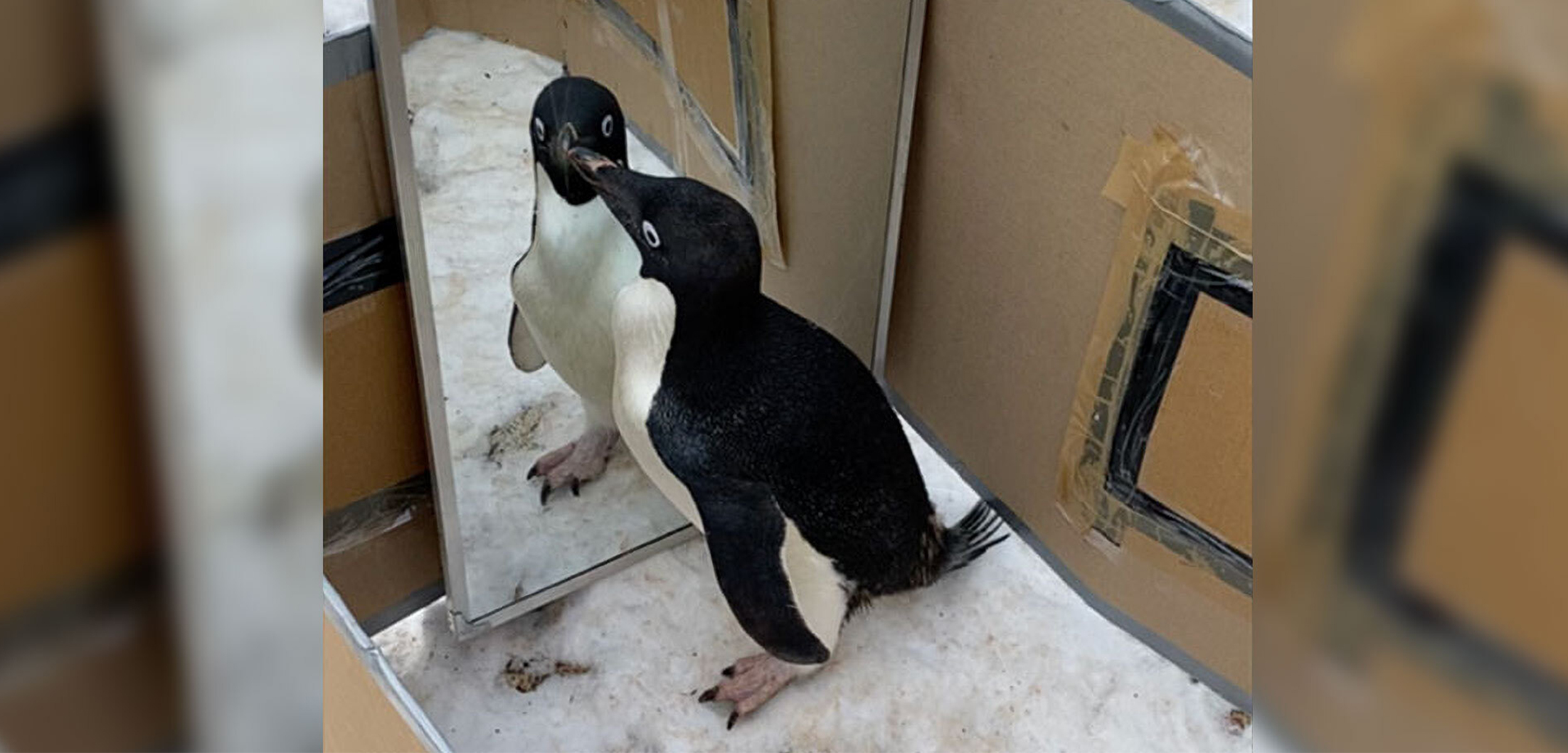Penguins May Have Passed the Mirror Test
Wild Adélie penguins respond to their own reflection, suggesting self-awareness.
Article body copy
Wild Adélie penguins in Antarctica have shown signs of self-awareness in a series of experiments that gauged their reactions to their own reflections.
Self-recognition is considered a key indicator of animal intelligence. The mirror self-recognition (MSR) test, in which animals are observed interacting with their reflections, dates back to experiments with chimpanzees in 1970. Typically, a subject is marked on an area of its body it would not be able to see without using a mirror. If the animal directs its attention to the mark while observing its reflection, it is considered to have passed.
The tests on the penguins took a slightly different approach. Rather than testing captive animals as in most MSR trials, the scientific team worked with wild penguins that were not habituated to people says study coauthor Anindya Sinha, a cognitive ethologist at the Indian Institute of Science. Because of this, the team made some modifications to the method to minimize distress for the birds.
In the first trial, they simply set a mirror in the path of a flock of penguins and waited for the birds to approach of their own volition. Several penguins approached the mirror and intently examined their reflections without touching or gesturing toward them.
In the next set of experiments, the scientists exposed individual penguins to mirrors under more constrained conditions. They used cardboard structures to briefly corral each test penguin and directed its attention toward either of two mirrors placed at the ends of the enclosure. Then, they showed the penguin a mirror onto which a circular sticker had been affixed at head level. Finally, they put a bib around the penguin before letting it look in the mirror again. The colored bib served the same purpose as the mark in the traditional MSR test, but the scientists opted for this easily removable version to avoid hampering the birds after the test was completed.
The results of this study are somewhat ambiguous. When the penguins looked in the mirror placed in the open, they carefully inspected their reflections but remained relatively motionless. When contained by the cardboard corrals, they tended to move and gesture in ways that suggested they were examining themselves. None of the penguins made aggressive or fearful motions toward the mirror that would indicate they believed they were looking at a stranger—common reactions in animals that don’t pass the test.
However, the penguins did become quite agitated by the stickered mirrors. All of the penguins pecked at the stickers as if trying to remove them. Intriguingly, when the scientists put the tiny bibs around their necks, the penguins made no efforts to examine or remove them, though the scientists aren’t sure why.
Most animals that have passed the MSR test attempt to examine or remove the mark on their body. In this case, the penguins ignored the bibs.
The penguins’ lack of interest in the bibs, says Sinha, may be explained by their aquatic habits. Penguins are “much more sensitive to the blue end of the color spectrum,” says Sinha. “They are rather insensitive to the other end, which is orange and red—the color of most of the bibs.”
This may indicate a minor flaw in the study—would blue or purple bibs have evoked a more dramatic response? It is also possible that the birds simply didn’t care about the bibs. Ellen O’Donoghue, a cognitive psychologist who was not involved in the study, suggests another explanation for the penguins’ lack of response to the bibs: “Maybe they’re not salient enough or not bothersome enough.
“There is a lot of potential for false negatives with the mirror test,” O’Donoghue notes. “What if an organism doesn’t perform those self-directed behaviors? Does it mean that they don’t have self-recognition?” she says.
“It’s very likely that there’s a continuum of self-concept and various behaviors that we can index at each stage of that,” she adds. “Mirror self-recognition is probably one of them.”
The study brings the number of birds that have shown at least some awareness of their reflections to four, adding Adélie penguins to the list alongside Eurasian magpies, Indian house crows, and pigeons.
Aside from birds, researchers have given passing grades on the mirror test to a number of organisms, including chimpanzees, a single Asian elephant, bottlenose dolphins, and even the cleaner wrasse and manta ray. One experiment suggests that animals as seemingly simple as ants may recognize themselves as well. The test, however, is controversial in part because many animals that have excelled at other intelligence tests have failed it—notably gorillas and African gray parrots.
Sinha thinks the study could have significant implications for our understanding of bird cognition.
“Penguins are a very ancient group of birds,” he says. Indeed, their earliest ancestors date to 60 million years ago. “Our ideas about the evolution of the self have so far been restricted to mammalian species.”

